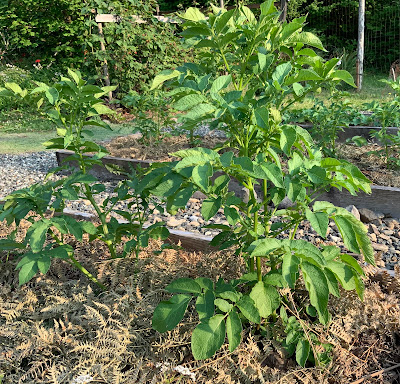Now that it’s officially fall…it’s prime mulch time!
 |
| Ferns and leaves on the potato bed |
Harvesting your summer crops, you may be looking bare, unprotected soil in your garden beds. And come springtime, those food-growing areas you cultivated all summer will quickly fill with weeds!
That’s where mulch—organic material that you lay on top of your garden beds—comes in.
Mulch is one of the cornerstones of sustainable, chemical-free food gardening.
In the growing season, mulching with leaves and other material from your garden will help suppress weeds, regulate soil temperatures, and keep more consistent moisture in your soil.
Over the winter, mulch will protect your soil by reducing soil heaving from frost/thaw cycles…plus as the mulch breaks down, it builds your soil!
Yesterday, I read a terrific article in the January ‘24 issue of Mother Earth News, “The Original World Wide Web”! It discussed the complex web of microbial life in the soil, and how organic material, applied to your soil, improves its fertility and in turn, crop production.
The article was fairly technical, so a bit tricky to sum up. But long story short, as organic material breaks down, it feeds the microbes in your soil, which helps fertility in myriad ways.
One particularly fascinating aspect to this process was that these microbes aid in the “communication” plants do through a web of their root structures—which in turn helps your soil increase the nutrients for your crops!
So…what to use for mulch?
Leaves: Hopefully you have a few deciduous trees around your yard, and in the fall, they’re on the ground for the taking! We have a beautiful small-leaved maple in our yard, which provides a large portion of leaves for mulch.
Other Foliage and Twigs: I also use a lot of brackenfern from the woods, which breaks down quickly. You can also use any foliage that doesn’t contain weed seeds. But…do not use fruit tree leaves or prunings, as they carry funguses.
Crop Foliage: I’ve been using more of my harvested material as mulch, and it works great! Instead of doing the high maintenance chore of chopping up the material, I lay it on top of my beds.
Besides leaves and ferns, here’s the crop material I’m using in the garden right now.
*Carrot tops
*Harvested pea pods
*Pea vines
*I’ve also saived my pea seeds, and just this week, planted as a sort of cover crop. The pea plants won’t grow much before the frost kills them, but they will provide some soil cover…plus their nitrogen-fixing roots will help the soil!
 |
| Empty pea pods to spread on top of the beds I just harvested |
I utilize wood chips (not beauty bark) for mulching my blueberry shrubs. Wood chips from deciduous trees and firs look great on paths too. However, I don’t use cedar chips around my food crops. Cedar wood contains oils that have a slight herbicidal effect.
*Squash foliage. After I harvest the squash, when the frost hits, I let all those abundant squash and cucumber leaves melt into the soil.
Parsnip foliage. I wait until the first killing frost to harvest parsnips, after the cold sweetens them up. Then I lay the cut tops on top of the bed!
I also top dress my tomato, squash and asparagus beds with well-composted chicken manure (originally mixed with wood chips). I’ve been rewarded with lush, healthy plants!
**Caution: like fruit leaves, do not use your spent tomato plants or potato plants as mulch—the foliage carries blights and funguses. On a similar note, do not discard spoiled tomatoes or potatoes in your compost pile.
If you’d like more details about mulch, here’s another post… And for lots of wildlife stories around our homestead, stop in at my newsletter, This Little Farm Life!
No comments:
Post a Comment